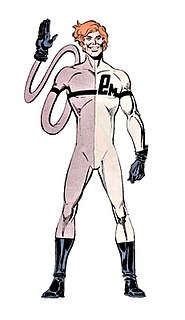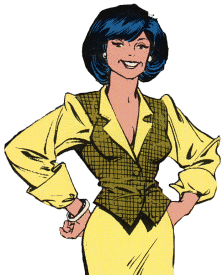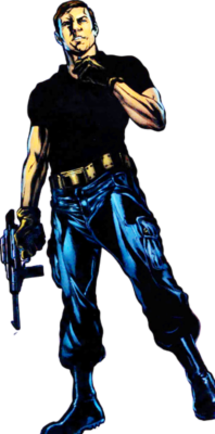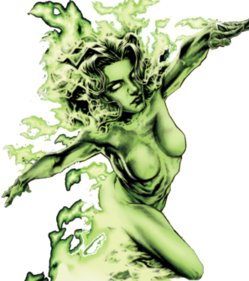
The Justice League is a team of fictional superheroes appearing in American comic books published by DC Comics. The team was conceived by writer Gardner Fox during the Silver Age of Comic Books as a reimagining of the Golden Age's Justice Society of America. Originally consisting of Superman, Batman, Wonder Woman, The Flash, Green Lantern, Aquaman and the Martian Manhunter, they first appeared together as the Justice League of America (JLA) in The Brave and the Bold #28.

The Elongated Man is a fictional character, a superhero appearing in American comic books published by DC Comics. His first appearance was in The Flash vol. 1, #112.

John Marc DeMatteis is an American writer of comic books, television and novels.
Keith Ian Giffen is an American comics artist and writer. He is known for his work for DC Comics on their Legion of Super-Heroes and Justice League titles as well as for being the co-creator of Lobo.

Booster Gold is a fictional superhero appearing in American comic books published by DC Comics. Created by Dan Jurgens, the character first appeared in Booster Gold #1 and has been a member of the Justice League.

L-Ron is a fictional character, a robot in the DC Comics universe. L-Ron first appeared in Justice League International #14.

G'nortEsplanade G'neesmacher is a fictional character, a DC Comics superhero. G'nort is a member of the Green Lantern Corps and later a Darkstar and a member of the Justice League Antarctica. He resembles a humanoid dog and is thoroughly incompetent and generally disliked by other heroes; in fact, he is usually portrayed as being a loser and used as comic relief.

Susan Dibny is a fictional character from DC Comics associated with the Elongated Man. Created by John Broome and Carmine Infantino, the character first appeared in Flash vol. 1 #119. In 2004, she became a flashpoint for discussions of women in comics when a highly controversial storyline was published in which she is murdered and revealed to have been raped by Doctor Light in the past.

Maxwell Lord IV is a fictional character appearing in comic books published by DC Comics. The character first appeared in Justice League #1 and was created by Keith Giffen, J. M. DeMatteis, and Kevin Maguire.

Ice is a fictional character, a comic book superheroine in publications from DC Comics.

Justice League Europe (JLE) was a DC Comics book run that was a spin-off of the comic book Justice League America.

Justice League International (JLI) is a DC Comics superhero team written by Keith Giffen and J. M. DeMatteis, with art by Kevin Maguire, created in 1987.

Fire is a fictional comic book superheroine from the DC Comics universe.

Jean Loring is a fictional character in comic books published by DC Comics, formerly associated with superhero the Atom for whom she was a supporting character and primary love interest. She first appeared in Showcase #34, created by writer Gardner Fox and artist Gil Kane. The character appeared continually in minor roles until the 2004 storyline Identity Crisis, in which she suffered a mental breakdown and murdered Sue Dibny, wife of the Elongated Man. This would later lead Loring to assume the mantle of the supervillain Eclipso.

Kevin Maguire is an American comics artist, known for his work on series such as Justice League, Batman Confidential, Captain America, and X-Men.

Theodore Stephen "Ted" Kord is the second Blue Beetle, an occasionally dead superhero who was originally published by Charlton Comics and later picked up by DC Comics. This version of the character was created by Steve Ditko and first appeared as a back-up feature in Captain Atom #83, with Gary Friedrich scripting from Ditko's conception and plot.
Catherine Maureen Cobert is a fictional character published by DC Comics. She first appeared in Justice League International vol. 1 #8, and was created by Keith Giffen, J. M. DeMatteis and Kevin Maguire.

Rocket Red is a fictional character and comic book superhero from the DC Comics universe. Created by Steve Englehart and Joe Staton, he first appeared in Green Lantern Corps #208, appearing shortly afterward in Justice League in issue #3 ; Rocket Red was inducted into the Justice League in Justice League #7.

Justice League: Generation Lost was a year-long comic book limited series that premiered July 2010. It ran twice a month for 24 issues, alternating with Brightest Day, which was written by Geoff Johns and Peter Tomasi.

Justice League 3000 is a comic book series published by DC Comics. Taking place in the future of the DC Universe as part of The New 52, the series features a 31st century iteration of the Justice League, with new versions of Superman, Batman, Wonder Woman, the Flash, and Green Lantern. The series is written by JM DeMatteis and Keith Giffen and illustrated by Howard Porter. Justice League 3000 began publication in December 2013.



















